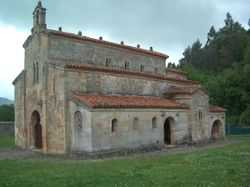Villaviciosa, Asturias
| Villaviciosa | |||
|---|---|---|---|
| Municipality | |||
|
Villaviciosa city hall | |||
| |||
 Location of Villaviciosa | |||
 Villaviciosa Location in Spain | |||
| Coordinates: 43°29′N 5°26′W / 43.483°N 5.433°WCoordinates: 43°29′N 5°26′W / 43.483°N 5.433°W | |||
| Country |
| ||
| Autonomous community |
| ||
| Province | Asturias | ||
| Comarca | Gijón | ||
| Founded | 17 October 1270 | ||
| Capital | Villaviciosa | ||
| Government | |||
| • Alcalde | Manuel Busto Alonso (Unión Asturianista) | ||
| Area | |||
| • Total | 276.23 km2 (106.65 sq mi) | ||
| Elevation | 662 m (2,172 ft) | ||
| Population (2011) | |||
| • Total | 14,962 | ||
| • Density | 54/km2 (140/sq mi) | ||
| Demonym | maliayo/a | ||
| Time zone | CET (UTC+1) | ||
| • Summer (DST) | CEST (UTC+2) | ||
| Postal code | 33300 and 33310 al 33318 | ||
| Official language(s) | Spanish | ||
| Website | Official website | ||
Villaviciosa is a town and municipality in the autonomous community of Asturias, Spain. It is situated on the central eastern coastline, and borders the Asturian municipalities of Gijón and Siero to the west, Sariego, Nava, Cabranes and Piloña to the south and to Colunga to the east. The total area is 271 km² and its population is 14,962 (2011). In this city was born José Ángel Hevia Velasco
History
In Prehistory, there were several Hill forts in Villaviciosa, most of them located in the axis of the ria, near Rodiles. During the time of the Kingdom of Asturias in the 8th century, the population moves away to Amandi, Camoca, Bedriñana, appearing frequently this county named as the Maliayo territory.
By the time of Alfonso IX of León, in the 13th century, the municipality begins to be developed and repopulated, being in 17 October 1270, when the King Alfonso X The Wise conceded the document which requires the population establishes in Buetes. At the same time, a Cistercian Order establishes in the valley of Boides creating the Monasterio de Santa María de Valdediós.
In the 16th century, the Emperor Charles I of Spain, V of Germany landed and hosted in the town, being this one of the most important events of the history of the Villaviciosa. The King arrived to the port of Tazones by because of a storm that changed the course of the whole court to Santander.
The 19th century leaves in the council the consequences of the Peninsular War against France. The town suffered numerous attacks, being the territory occupied several times by the French troops, until they were finally expelled. In 1835, the county is officially established and since this century, municipal business grows significantly due to the location of the ria, at that time navigable.
Currently, Villaviciosa is the most important municipality of Asturias in production of cider. The town also produces milk and has an important reliance on tourism, with natural landscapes and several beaches in the town.
Parroquias
The capital of Villaviciosa is the one with the same name. It is 2 km2 (0.77 sq mi) in size, with a population of 5,000 (INE 2006). The postal code is 33300.
Villaviciosa includes, with this one, 41 parroquias (parishes):
|
External links

(13th century).
| ||||||||


